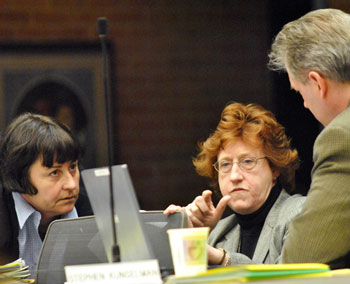Ann Arbor city council meeting (Aug. 4, 2011): In the early part of the meeting, mayor John Hieftje effectively headed off a debate that might have otherwise unfolded among councilmembers on the relationship between the taxes collected for street and sidewalk repair and the city’s public art program. The mayor announced that he’d be nominating Tony Derezinski (Ward 2) to serve on the public art commission as a replacement for recently resigned commissioner Jeff Meyers. And Hieftje went on to say that in September he wanted to take a longer look at the city’s public art program.

From left: Stephen Kunselman and Mike Anglin congratulate each other on winning their respective Democratic primary elections two days earlier. Kunselman represents Ward 3. Anglin represents Ward 5. Both are incumbents. (Photo by the writer.)
That assurance was enough for now to hold off a council discussion of an explicit restriction on the street/sidewalk repair tax – a restriction that would prevent those tax monies from being used to pay for public art under the city’s Percent for Art program. At the meeting, the council approved ballot language for Nov. 8 that will ask voters to renew the street repair tax (at a rate of 2.0 mills) as well as to approve an additional tax to repair sidewalks (at a rate of 0.125 mills).
But no discussion took place on a possible restriction on those monies in connection with public art. It’s technically possible for the council to revisit the issue at its next meeting, on Aug. 15, which falls one day before the ballot language must be filed, according to the state election statute.
If the discussion of appropriate funding mechanisms for public art is pushed to September, it will join another topic the council voted at its meeting to postpone for two months – termination of the city’s contract with RecycleBank. That company administers a coupon-based incentive program in connection with the city’s new single-stream recycling program.
It was a year ago, in July 2010, that the new single-stream system replaced Ann Arbor’s decades-old dual-stream system. Councilmembers questioned the evidence that RecycleBank’s program had any significant impact on residents’ recycling behavior. The measure needed an eight-vote super majority of the 11 councilmembers, and based on deliberations, there were only seven clear votes to terminate. But instead of voting, the council postponed the issue.
The council did take action on a related recycling issue, voting to increase its annual contract with Recycle Ann Arbor, which empties the curbside recycling carts set out by residents. The increase was set for $107,000 a year and was meant to offset diminished revenue that Recycle Ann Arbor was getting under the contract, due to a smaller number of carts being deployed in the city.
In other business, the council gave final approval to changes in employee benefits. It also approved terms of a contract with Steve Powers, who on Sept. 15 will become the city’s newest employee as city administrator. Highlights include a $145,000 base salary and participation in a 401(a) plan instead of the city’s pension system.
Allen Creek was the geographic focus of two items on the agenda. The council approved another extension to the purchase option agreement with Village Green – for the City Apartments project to be located at First and Washington. The council also approved a general expression of support for the idea of constructing a greenway in the Allen Creek corridor.
The council also approved revisions to the proposed Burton Commons housing development, located on Burton Road near Packard and US-23. And receiving initial approval were changes to the boundaries for the city’s five wards.
Highlights of council communications came from Sandi Smith (Ward 1) and Stephen Kunselman (Ward 3). Smith alerted her colleagues to possible legislation she’d be bringing forward in the future that would restrict video surveillance. Kunselman announced that he would eventually be bringing forward possible revisions to the city’s ordinance that governs how its downtown development authority operates.
A highlight from public commentary was praise heaped upon the Ann Arbor police chief, Barnett Jones, by a representative of the Washtenaw Interfaith Coalition for Immigrant Rights (WICIR). [Full Story]






